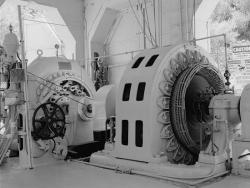This Creative Development Which Was Responsible For The Survival Of The Cotton Industry In The United States Occurred In General Nathaniel Greene's Plantation Near Savannah 10 Miles Northeast Of This Marker. Separation By Hand Labor Of The Lint From The Seed Of The Desired Upland Variety Of Cotton Produced Only One Pound Per Day Per Person. Eli Whitney, A Native Of Massachusetts And Yale Law Graduate, Came To Georgia To Teach School In Late 1792, At Age 27. Mrs. Catherine Greene, Widow Of General Greene, Invited Whitney To Her Plantation, And Urged Him To Design A Cotton Gin.
USA
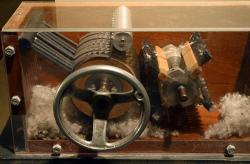

Farm And Residence of John Johnston 1791 - 1880 Eminent Farmer Who Here Originated Tile Underdrainage in America in 1835 and Thereby Became an Outstanding Contributor to Human Welfare Honored by The American Society of Agricultural Engineers 1935. Erected by State Education Department

Established in 1907, the American Society of Agricultural Engineers (ASAE) was managed by volunteers. In 1925, local editor Raymond Olney was named secretary, thus establishing ASAE in this area. By 1969, with over 7,000 members in 100 countries, an ASAE building was constructed at this site in St. Joseph, Mi. In 2005, ASAE became ASABE to recognize the importance of biology in the profession. ASABE collects and maintains the unique body of knowledge for the agricultural/biological engineering profession.
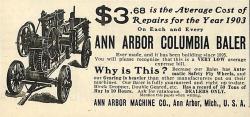
Designated an Historic Landmark of Agricultural Engineering. In the Shelbyville Area During the Spring of 1929, Raymore McDonald Designed and Developed the First Commercial Pick-Up Baler as Conceived and Financed by Horace Tallman and His Sons, Leslie R. and Gentry L. These Balers were Marketed for Many Years by the Ann Arbor Machine Company of Shelbyville. This Concept of Field Processing of Farm Forages Made a Significant Contribution to the Efficiency and Economy of Mechanized Forage Harvesting in the World's Agriculture.
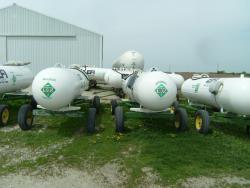
In 1932, J. O. Smith, Agricultural Engineer at Delta Branch Experiment Station in Stoneville, MS, attached a small anhydrous ammonia cylinder to a plow in such a manner that the NH3 was released in the soil. The plow, a Georgia Stock, was pulled by a gray mule named Ike. This was the first known use of anhydrous ammonia as a soil-applied crop fertilizer. The crude apparatus and the anhydrous ammonia it applied provided a much needed source of nitrogen for the otherwise rich alluvial soils of the Mississippi Delta.

A crucial step in the evolution of modern plant agriculture was the development of low-cost, energy-efficient greenhouse structures that provide optimum growing conditions year-round. In 1964, Professor William J. Roberts developed the first air-inflated double-layer polyethylene greenhouse covering system at Cook College, Rutgers University.

American Society of Agricultural Engineers Founded in this Building December 27, 1907

Agricultural Aviation Began In 1921 When C. R. Neillie Got A Military Plane To Dust Catalpa Trees Near Troy, OH. In 1922 B. R. Coad And C. E. Wollman Began Research At Tallulah, LA To Control Boll Weevils In Cotton. They Developed Equipment Using Venturi Induction, Ram Air Pressure And Hopper Agitation. G. B. Post And Wollman Made The First Commercial Dust Applications In Macon, Ga In 1924. In 1925, 18 Aircraft Treated 60,000 Acres Of Cotton Across The South. In 1928, Delta Air Service Was Organized.
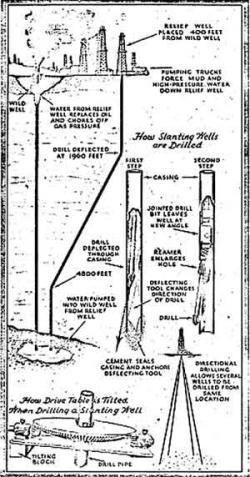
H. John Eastman introduces controlled directional drilling in 1929 and was awarded a patent the following year.
The technique became widely adopted after an oil strike in Conroe, Texas, caught fire in January 1933. The well exploded, creating a 600-foot deep crater, and the oil burned for months. Although the fire was eventually put out, oil continued to flow into the “lake.” The only way to manage this was to drill another well to relieve the pressure.

This Federal Laboratory has played a pivotal role in creating our modern air traffic control system. Established as the National Aviation Facilities Experimental Center in 1958, the Technical Center’s research and engineering achievements, and its direct support to airports and FAA air traffic control facilities have led to the highest level of safety in air transportation.
Innovations
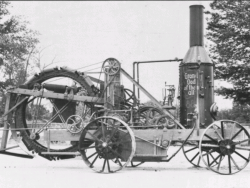
During the post-Civil War era, efforts to cultivate the land for higher crop yields resulted in the digging of thousands of miles of ditches to improve land drainage. Accurately graded ditches were needed for open drainage, pipeline trenches and placement of underground agricultural drainage…
Read More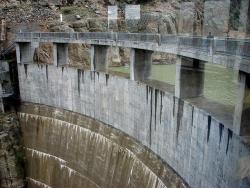
The Buffalo Bill Dam, known as the Shoshone Dam until 1946, was the first mass concrete dam in America. At nearly 325 feet high, it was also the tallest dam in the world at the time of completion.
This was one of the first arch dams in the U.S. to be designed using a mathematical method…
Read More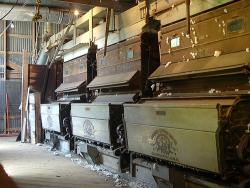

Cabin John Aqueduct, designed by Montgomery C. Meigs, conveys drinking water from Great Falls, Maryland to Washington, D.C. It was the longest stone masonry arch in the world for nearly 40 years. The segmental arch of the bridge has a span of 220 feet and a rise of only 57 feet. The main arch…
Read More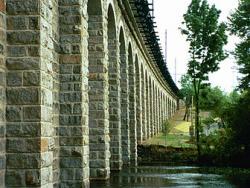
For more than 174 years, the Canton Viaduct has stood as a dominating structure on the New England landscape. When completed in 1835, the slightly curved, granite masonry bridge - 615 feet long, 70 feet high, and 22 feet wide - carried a single track of the Boston and Providence Railroad,…
Read More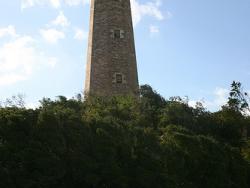
The Old Cape Henry Light house was the first construction project authorized by the First Congress. Constructed by John McComb, Jr. of New York City, this project set the stage for all subsequent public works projects of the Federal Government. In addition, this specific lighthouse was a vital…
Read More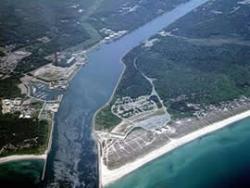
The idea of a canal eliminating the costly and dangerous sea trip around the Massachusetts peninsula of Cape Cod was envisioned as early as 1623 by Pilgrim leader Miles Standish. It was not until financier August Belmont became involved in 1906, however, that sufficient funds for the project…
Read More
The Atlantic Ocean's northward-flowing Gulf Stream meets the southward-flowing Labrador Current at a point marked approximately by North Carolina's Outer Banks. Since the earliest days of United States commerce, shifting tides, inclement weather, treacherous shoals, and a low-lying shoreline…
Read More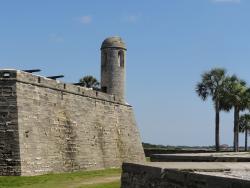
The fort was constructed of coquina rock. Unique to Florida, the rock consists of millions of seashells cemented together. It proved highly durable and easily absorbed the force of many cannon balls.
The Castillo de San Marcos was the first permanent European settlement in the…
Read More
In 1894, Catawba County, North Carolina commissioners asked local landowners to build and maintain an 85-foot-long bridge across Lyles Creek. The community hired Andy L. Ramsour, who served as keeper of the Horseford covered bridge over the Catawba River in Hickory, North Carolina.
…
Read More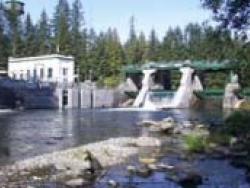
Requests for public power in Seattle began in the late 1890s and lead to the voter approval for building the Cedar Falls Water Supply hydroelectric dam plant in 1902. The first municipally developed and owned hydroelectric plant in the United States began operation in October 1904. The facility…
Read More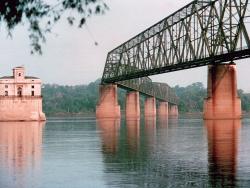
Clarifying the turbid waters of the Mississippi River for use as drinking water was a formidable challenge. The Chain of Rocks Water Purification Plant provided the first application of a system of flocculation, sedimentation, and rapid sand filtration for water purification.
The system…
Read More
The William H. Chandler Chemistry Laboratory was conceived and planned by William Henry Chandler (1841-1906), professor, chairman, librarian, and acting president of Lehigh University. Designed by Philadelphia architect Addison Hutton and erected between 1884 and 1885 at a cost of $200,000, the…
Read More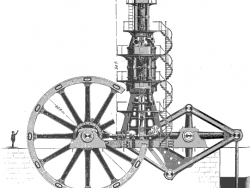
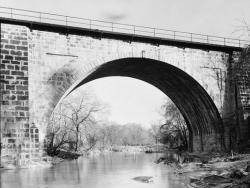
The Carrollton Viaduct over Gwynn's Falls was the first masonry railroad viaduct constructed in the United States. This structure proved the feasibility of using a viaduct to transport railway vehicles across wide and deep valleys.
The concept for the viaduct came from international…
Read More
The Cheesman Dam was the first major dam in the U.S. to incorporate the gravity arch, and upon completion it was the highest gravity arch stone masonry dam in the world. It is the key structure in Denver's water supply.
Three years into original construction, flooding swept away the…
Read More
The Chesapeake & Delaware Canal is the only canal built in 19th-century America that still operates today as a major shipping route. Connecting the Port of Baltimore and Upper Chesapeake Bay with the mouth of the Delaware River and the Port of Philadelphia, the canal was one of the first…
Read More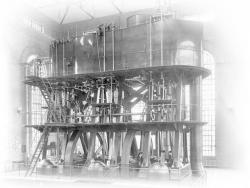
At the site of the first water pumping station providing water and sewage systems to the City of Erie in 1868, the Chestnut Street Pumping Station houses one of the largest steam engines, which pumped 20 million gallons a day. The triple-expansion steam reciprocating engine, which pumped water…
Read More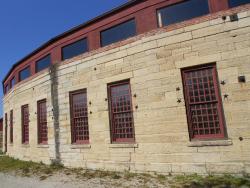
The Chicago, Burlington, & Quincy Railroad was the first railroad to link Chicago and the Mississippi River, in the 1850s. This forty-stall roundhouse, large even for its time, became a major center for railroad activity for the CB&Q. It served as a repair and construction facility from…
Read More